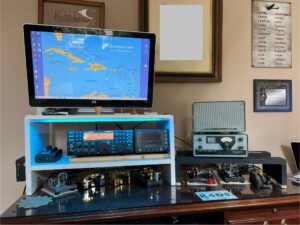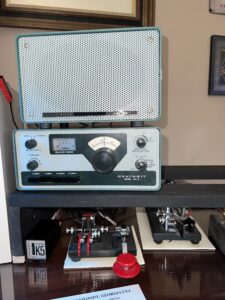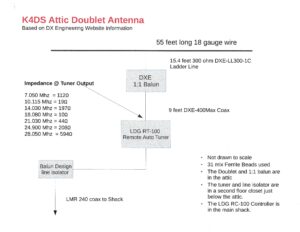Station Setup
In December 2016 the QTH was downsized to a Cluster Home community with HOA rules. Flying under the radar while following the rules is required.
Note to hams downsizing: adjusting to a small space for operating can be easy, but a small space for antennas is a no no. Needless to say, I miscalculated. Please see my Operating in the shadows page.
The Shack
 The shack is located in the second floor study. The picture to the left is of the operating position on July 24, 2024. The Elecraft K3/P3 combo is sitting on the lower shelf (a Penntek TR-25 is stored to the left of the K3) and the computer monitor is located on the top shelf. On the desk surface under the transceiver are three iambic paddles (two Begali and a Vibroplex) and the Begali Intrepid bug. Attached to the left side of the white shelf is the LDG remote antenna tuner control. On the single shelf to the right is an HW-8 QRP Transceiver and HR-1661 speaker. Under the transceiver on the desk surface is a Broiwn Bros. combo key, a 1944 Vibroplex bug and a Begali straight key. Out of the photo is an Astron RS-35M power supply, a Yaesu YD-148 microphone (rarely used, but has come in handy in snagging a few new Parks) and a Radiosport headset. Also, out of the photo on a pullout keyboard shelf is a Bluetooth keyboard, mouse, NorCal 40B and Lafayette Radio Electronics MS-435 Bug key. Left click to enlarge for a better view.
The shack is located in the second floor study. The picture to the left is of the operating position on July 24, 2024. The Elecraft K3/P3 combo is sitting on the lower shelf (a Penntek TR-25 is stored to the left of the K3) and the computer monitor is located on the top shelf. On the desk surface under the transceiver are three iambic paddles (two Begali and a Vibroplex) and the Begali Intrepid bug. Attached to the left side of the white shelf is the LDG remote antenna tuner control. On the single shelf to the right is an HW-8 QRP Transceiver and HR-1661 speaker. Under the transceiver on the desk surface is a Broiwn Bros. combo key, a 1944 Vibroplex bug and a Begali straight key. Out of the photo is an Astron RS-35M power supply, a Yaesu YD-148 microphone (rarely used, but has come in handy in snagging a few new Parks) and a Radiosport headset. Also, out of the photo on a pullout keyboard shelf is a Bluetooth keyboard, mouse, NorCal 40B and Lafayette Radio Electronics MS-435 Bug key. Left click to enlarge for a better view.
Antenna(s): Below to the right is my current main antenna system. It is in the attic and is still being tested. HOA plus a very small yard = low power levels, stealth antenna systems and “nothing to see here.” Left click to enlarge for a better view.
When in a cluster home community, it is a challenge to keep the antenna system closer to your QTH than your neighbors. In my case, since there is minimal yard and no trees, keeping the antenna system close to our house is easy – it is in or on it. The downsized antenna system chronology is as follows:
- It began as two ham sticks, one for 30 meters and one for 40 meters mounted of the back deck. The 40 meter one proved to be a little more than a skinny dummy load, while the 30 meter version performed a bit better.
- The second installation was a 47 foot wire attached to the trim of the house. At first the wire was tuned with an old Murch UT-2000A manual transmatch. The old reliable Murch and circuit design came through and performed flawlessly. To automate things, shortly after installing the wire the manual tuning method was replaced by an MFJ-926B automatic remote tuner. The wire was attached to and followed the trim of the house. At the furthest point from the tuner it was only about 12 feet high. The wire climbs to about 22 feet at a 45 degree angle and immediately turns down at the same angle to 12 feet again running at that height along the house until it turns down a few feet into the tuner. The system included five raised radials. This antenna was the main antenna system used for several years.
- The third installation contains attic doublets. The first was one cut for 40 meters, fed with 450 ohm ladder line and tuned with an MFJ-974H tuner. The second version and in use at the time of this writing is a 55 foot doublet fed with 300 ohm twin lead through a DX Engineering 1:1 current balun. This second version was originally tuned with the MFJ-974H tuner, but an automated tuning system is currently bring tested. See the diagram above for more details.
The plan is to have a good match at the antenna itself not a forced match at the transceiver. The thought is to keep loses along the coax at a minimum. Also, I want to minimize common mode currents on the transmission lines so only my antennas resonate not everything else.
Old time section
 The right side on the operating desk houses the old school gear (pictured here on the right). Not old enough to be from my early days in the hobby, but old non the less. The transceiver is a Heathkit HW-8 (no mods – the way I like it) on the market from 1976 to 1983. The speaker is a Heathkit model HS-1661. The keys used with the radio are a 1944 Vibroplex original bug and a Brown Brothers CLT-B combo key manufactures from 1976 to 1979. The keyer is a Curtis Lil Bugger circa 1981.
The right side on the operating desk houses the old school gear (pictured here on the right). Not old enough to be from my early days in the hobby, but old non the less. The transceiver is a Heathkit HW-8 (no mods – the way I like it) on the market from 1976 to 1983. The speaker is a Heathkit model HS-1661. The keys used with the radio are a 1944 Vibroplex original bug and a Brown Brothers CLT-B combo key manufactures from 1976 to 1979. The keyer is a Curtis Lil Bugger circa 1981.
Left click the picture to enlarge for a better view.
RFI test lab
Since the antennas and all the electrical/electronic workings of the QTH are so close together, the fear is that there could be a lot of RFI. The concern is amplified by the fact that all the houses in the neighborhood are on top of each other so interference may affect many. When I write about RFI I tend to be focusing on RFI resulting from RF transmission from the radio. However, tight living also introduces RFI at the receiving end.
Shacks from the past
Although photography was a big hobby in the past, very few pictures were taken of my radio areas, Below are a few:






